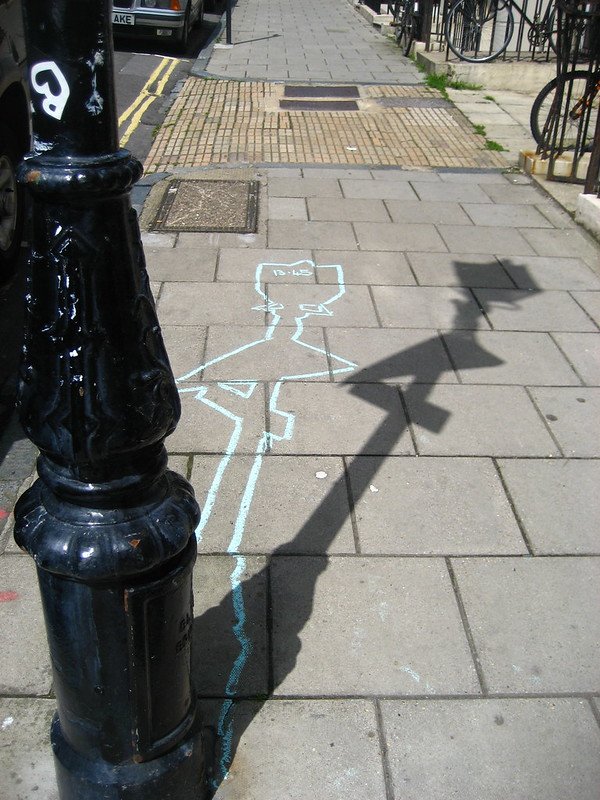Picture, if you will, a lamp post on a sunny day. The sunlight falls on the post, and from the other side stretches a dark shadow along the sidewalk. Every day at 9 o'clock in the morning, you go to the lamp post's shadow with a stubby piece of chalk in your hand. Scraaatch. Scriiiitch. Scraaatch. And the outline is done.
Later in the day, the sun falls victim to clouds of rain. The torrent cools the air and cleans away some of the dirt and dust that settled on the sidewalk. But your outline is gone too. Well, no matter. 9 o'clock rolls around again, and you dutifully draw the outline once again.
Rain, and chalk. Downpour, then chalk. Precipitation, and again chalk. After some days, you notice that some of the chalk is staining into the cement. In the interest of efficiency, you break out your trusty hammer and chisel instead of the chalk, and start etching the line. That’ll show the rain!
Then, no matter what time of day you go out there, you can draw in the outline. Doesn't matter if it's 9 o'clock in the morning - you just follow the etched shape on the sidewalk. It's not a great outline, to be honest. But it's your outline, darn it, and you've worked a good portion of your life to make it.
Every one of us, at some point in life, took out that hammer and chisel, and we etched an outline of how we thought and felt about ourselves. We engraved that list in our brains, of "I'm good at this, but I'm really bad at that." "I won't be good at volunteering, because it doesn't fit my personality." "I can't sit in silence for very long - it's just not who I am, and I'll go nuts!"
As Rich Plass writes, we are all addicted to a certain way of being ourselves. We've worn in the edges of that particular shadow so often - sometimes dutifully, but often subconsciously - that we find ourselves acting on reflex. We know where the rough edges are that we want to hide. We know where the straight lines and smooth curves are that we can proudly show off to the rest of humanity.
That's how we like to interact with reality. But reality often has a different idea, and it throws a curveball. Someone happens along to our lamp post in the afternoon and comments on how long the shadow is at this time of day. Then we feel it - they must be wrong. They're looking at us the wrong way. If only they knew what was going on in our lives when we chiseled out some of those edges - then they might understand. But really, how could they know?
But feelings don't always match reality, do they? If someone tells you that you are loved and appreciated, do you feel loved and appreciated? Maybe you've been told you are a good person, then felt guilty that you're obviously deceiving everyone.
In the Christian life, we have the added dimension: who we are in Christ. One more layer of objective reality to add to all the others - it makes everything so complex! Or so it feels, anyway. Some would say that's the only layer that matters, but that seems wrong because so much seems to matter right here and now.
None of it - what people say, what the Bible says - none of it matches our well-worn outline of who we are. So either that input is wrong, or the output of my subjective experience is wrong, or the machine of who I am is just broken.
Here's the place where a lot of people put the Bible aside. I get it - that's one way to solve the dissonance. But if you, like me, accept the scripture as true even in the face of that discord of reality and experience, it leaves a disturbing realization: even though we are in Christ and have the Spirit, we are still broken.
From there, we have a couple of ways we can go. Realistically, we often follow the path of least resistance. So we'll acknowledge briefly that someone might be right about something, but function as though our outline were correct the whole time: "I can kind of see how you could love me. But I know what I'm really like, and I'd best keep that hidden." Or, we'll say the Bible is true and we'll see that someday, but right now we're dealing with something else entirely.
The more difficult way is one that will often drain us of energy and probably frustrate us as well. We could give ourselves permission to see another perspective of us. We could learn to trust certain voices around us in their descriptions. We could begin to contemplate how that layer of who we are in Christ might affect our lives here and now.
If we go there, that's the path of striving. The Holy Spirit will help, but we'll also have days that we just don't feel the energy - we're tired, and we ease into that well-worn outline that just won't go away. Then we might get down on ourselves, because we feel like we haven't made any progress on breaking out of the patterns, the paradigms, or the weak spots. So we will need to continue to seek help to lay aside those tired old neural pathways and lay in new ones that are closer to matching what we are.
Following the more difficult path is also the way to learning more of grace.
References:
"Chalk outline and shadow" by adactio is licensed under CC BY 2.0
Plass, Richard, and James Cofield. The Relational Soul: Moving from False Self to Deep Connection. Ivp Books, 2014.

Leave a comment in response to the post: